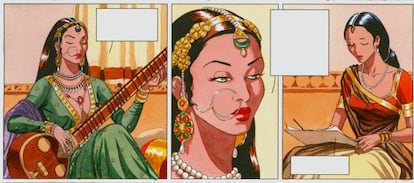The women comic book artists who are proving a big draw
“Now it is a livelihood, but back when I started it was simply unthinkable"

If there is any noticeable trend in the Valencian comic book scene, besides the success of Paco Roca (the creator of Arrugas, the award-winning story about Alzheimer's disease), it would be the rise of women cartoonists.
At first it was just Ana Miralles and Ana Juan. It was the 1980s, and they were working in a male-dominated world. Juan eventually concentrated on illustration work, but three decades later Miralles is still putting out new comic books.
"Back then, comic books did not make for an impressive calling card," she recalls. "People did not think that was a serious job. By persevering, by not giving up on our dreams, many of us have turned comic books into our livelihood and into a full-time job; but back when I started it was simply unthinkable."
Born in Madrid in 1959, Ana Miralles lived in Valencia from 1973 to 2006. These days she lives in Santander, where she moved because "there came a time when conditions became unlivable there because of the construction boom." Miralles jokes she considers herself "an environmental refugee."
She normally works for companies in Belgium and France, which in turn sell the rights to Spain and other countries. Her eighth album series, Djinn, took first prize at the 27th Barcelona International Comic Fair.
She always remembers reading comic books at home, just as her parents and sister did. "It was in the last year of my fine arts studies when I decided to devote my life to comic books. It was a slow but inexorable process," she says.
In the case of Cristina Durán, 41, the decision came long before that. "I studied fine arts precisely because of comic books," says the illustrator, who met her romantic and professional partner, Miguel Ángel Giner, through a fanzine, No Aparcar Llamo GRÚA.
Durán was the only female student in her class who drew comic books, but she won several prizes for amateur cartoonists. Then, working out of a studio in Benetússer called La Grúa Estudio, she found a niche in the international market with her first graphic novel, Una posibilidad entre mil, a finalist in the 2010 National Comic Book Prize.
"It was Miguel Ángel who convinced me to make a graphic novel that would tell the story of Laia; there was this need to take the story out," she says in reference to her own daughter, who suffers from cerebral palsy. "Besides, we had to make it a positive story in the end."
Besides these two well-placed cartoonists, there are new names pushing their way up such as Lydia Sánchez and Julia Cejas. Asked how you get to where she is right now, Durán says: "You have to fight for it, because it's not just about enjoying your own creative work, but also about being good professionals and being able to make a decent living out of it."
Tu suscripción se está usando en otro dispositivo
¿Quieres añadir otro usuario a tu suscripción?
Si continúas leyendo en este dispositivo, no se podrá leer en el otro.
FlechaTu suscripción se está usando en otro dispositivo y solo puedes acceder a EL PAÍS desde un dispositivo a la vez.
Si quieres compartir tu cuenta, cambia tu suscripción a la modalidad Premium, así podrás añadir otro usuario. Cada uno accederá con su propia cuenta de email, lo que os permitirá personalizar vuestra experiencia en EL PAÍS.
¿Tienes una suscripción de empresa? Accede aquí para contratar más cuentas.
En el caso de no saber quién está usando tu cuenta, te recomendamos cambiar tu contraseña aquí.
Si decides continuar compartiendo tu cuenta, este mensaje se mostrará en tu dispositivo y en el de la otra persona que está usando tu cuenta de forma indefinida, afectando a tu experiencia de lectura. Puedes consultar aquí los términos y condiciones de la suscripción digital.
Últimas noticias
Maduro pleads not guilty before the federal court in New York: ‘I am still the president of Venezuela’
A new test can detect Alzheimer’s from a finger prick
UN team enters Sudanese city of El Fasher after paramilitary massacre: ‘It’s like a ghost town’
A recipe for resistance: Indigenous peoples politicize their struggles from the kitchen
Most viewed
- Gilles Lipovetsky: ‘If you want to live better and fall in love, take Prozac, don’t look to philosophy’
- Alain Aspect, Nobel laureate in physics: ‘Einstein was so smart that he would have had to recognize quantum entanglement’
- Alvin Hellerstein, a 92-year-old judge appointed by Bill Clinton, to preside over Maduro’s trial in New York
- Why oil has been at the center of Venezuela-US conflicts for decades
- Cuba confirms death of 32 of its citizens in the US attack against Venezuela








































